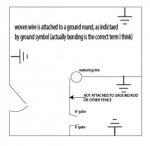Hi all, so I had a professional install my fence for our cattle, goats, llama and pigs, just a pasture fenced in a rectangle with a bull pen integrated. The bull pen shares 2 sides with the main pasture fence. The posts are wood, the fence is woven wire and I have 2 hot wires, one at the top and one about 10" off the ground. The hot wires are totally isolated from the woven wire with insulators, as far as I can tell no hot wire touches the woven wire. They put 2 ground rods at separate locations and attached the woven wire to those rods. He said it was to prevent the electricity from arcing to the woven wire from to hot wire. I was thinking, "gosh if there is enough power to arc 8" that will kill my cattle", but he said that is how he does it.
See those 2 6' gates in the image, well when you touch both gates you get a little shock, as long as the gates are not touching.
If you are touching both gates and getting shocked and then close the gates so they touch you stop getting shocked.
The hardware that holds the gates was touching the woven wire on both gates, so I cut the woven wire so it would not touch the gate hardware and no more shock. Any idea what is going on?
Some thoughts:
Maybe some electricity is flowing underground from the 2 ground rods in the barn for the fencer (100' feet away) and in turn to the ground rods he installed for for the woven wire, thus energizing the woven wire and in turn the gate hardware, except for that one section that is not attached to a ground rod, effectively creating a potential difference from one gate to the other, thus the shock. I surmise that when you touch the gates together your making then equipotential and no shock. Possible?
The bottom hot wire does touch some grass, the grass touch the woven wire . . . can that be how the woven is getting energized?
Maybe the hot wire is touching the woven somewhere and I can't find it?
For now I have stopped the shocking part, but I want to know why this was happening and as far as I am concerned it is not fixed because the same electrical condition still exists, all I did was cut the woven wire as a temporary fix. The fence guy said it was mystery, I think not and I want to solve it.
e.
See those 2 6' gates in the image, well when you touch both gates you get a little shock, as long as the gates are not touching.
If you are touching both gates and getting shocked and then close the gates so they touch you stop getting shocked.
The hardware that holds the gates was touching the woven wire on both gates, so I cut the woven wire so it would not touch the gate hardware and no more shock. Any idea what is going on?
Some thoughts:
Maybe some electricity is flowing underground from the 2 ground rods in the barn for the fencer (100' feet away) and in turn to the ground rods he installed for for the woven wire, thus energizing the woven wire and in turn the gate hardware, except for that one section that is not attached to a ground rod, effectively creating a potential difference from one gate to the other, thus the shock. I surmise that when you touch the gates together your making then equipotential and no shock. Possible?
The bottom hot wire does touch some grass, the grass touch the woven wire . . . can that be how the woven is getting energized?
Maybe the hot wire is touching the woven somewhere and I can't find it?
For now I have stopped the shocking part, but I want to know why this was happening and as far as I am concerned it is not fixed because the same electrical condition still exists, all I did was cut the woven wire as a temporary fix. The fence guy said it was mystery, I think not and I want to solve it.
e.


